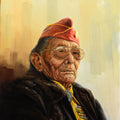See Julian Onderdonk's Texas bluebonnet paintings at San Antonio Museum of Art
By Medicine Man Gallery on

Julian Onderdonk, Near San Antonio (1918) detail. San Antonio Museum of Art. Photo by Chadd Scott
The bluebonnet paintings of Julian Onderdonk have always captivated me. Something of a dream, they are.
I began visiting the Texas Hill Country where Onderdonk lived and painted in the 1980s. My maternal grandparents retired to Lago Vista, TX on Lake Travis outside of Austin, and family trips regularly took me there. This was long before I had an interest in art or knew who Onderdonk was.
But I knew well who Julian Onderdonk was on a March 2023 visit to San Antonio which included a stop at the San Antonio Museum of Art, where a number of Onderdonk’s bluebonnet paintings, including one of the best you’ll find anywhere, Near San Antonio (1918), can be seen.
It’s a luminous painting. Large – about 3-by-4 feet. Fields of bluebonnets, the Texas state flower, spread out toward the horizon over rolling hills as far as the eye can see. Interspersed are prickly pear cactus and scrubby trees. A soft light makes them glow on a spring morning the beauty of which anyone would be privileged to experience just once.
Robert Julian Onderdonk (1882-1922) was a San Antonio native. He’s referred to by his middle name because his father, Robert Jenkins Onderdonk (1852-1917), was also a painter, one of San Antonio’s earliest professional artists. Julian is also referred to as “the father of Texas painting.”
Unknown to me, and well detailed at the San Antonio Museum of Art, was the time Julian Onderdonk spent in New York. He finally convinced his father to let him travel there for art school in 1901, attending the Arts Student League. Other famous Arts Student League enrollees over the years include Fredrick Remington, Georgia O’Keeffe and Jackson Pollock to name a few.
Onderdonk, in fact, would spend more than the next decade splitting his time between the New York City area and Texas before moving back to his home state for good in 1912.
In New York, he would also study with famed American impressionist William Merritt Chase. You can see the artistic resemblance between Onderdonk’s portrayal of Texas Hill Country and Chase’s New England landscapes. He also later studied for a period with another titan of American art, Robert Henri.
In addition to Onderdonk’s bluebonnet paintings, SAMA displays a variety of his paintings from, and of, New York. Hudson River View (1912) and October Day on Staten Island (1908) were on view when I visited.

Julian Onderdonk, October Day on Staten Island (1908). San Antonio Museum of Art. Photo by Chadd Scott
While his New York pictures were good, they lack the intimacy, the feeling of his Texas paintings. Onderdonk skillfully reproduces the trees and the clouds – technically expert, realistic, museum quality – but overall, they miss the nuance of the light and atmosphere which define his bluebonnet paintings. Capturing those ephemeral characteristics, subtleties which can only be appreciated after years and years of looking and living, defy the artist’s eye and brush – even the best – when they’re simply interloping.
I’ve seen this before in the brilliant Stuart Davis’ attempts to paint New Mexico. Davis is one of my favorite early 20th century American Modernists. I especially enjoy his energetic, frenetic, vertical, angular, cityscapes. Davis was a city painter. Born in Philadelphia, studied in New York, lived in New York. He knew the city the way Onderdonk knew the hills and meadows of south Texas.
Davis spent five months in Santa Fe during 1923, admiring the landscape, visiting the Pueblos, attempting to paint the area. He did, but with nowhere near the proficiency of his cityscapes or New England coastal scenes more familiar to him. Many of Davis’ New Mexico paintings hang in prominent museums – the Amon Carter Museum of American Art in Ft, Worth has one – it’s OK.
You can tell it’s a Stuart Davis, it’s interesting, but, like Onderdonk painting New York, Davis’ New Mexico paintings fail to deftly capture that place’s unique character, it’s blaring light, the quality of its air and atmosphere and essence.
He’s a fish out of water and the picture reflects that.
Which shouldn’t come as a surprise. Think of how visually different the Texas Hill Country or New Mexico are from Manhattan and New England. Not only the topography, but the light, the air, the atmosphere, the sky.
An artist’s eye is trained not over months and years, but decades. Decades of observation, of looking, of noticing subtle differences in light and shadow, of the changing seasons.
Few painters demonstrate equal mastery of wildly varied landscapes. Claude Monet’s paintings in and around Paris as well as his scenes from the Italian Riviera come to mind. He could paint a smokey, sooty urban train station with equal expertise as a poppy field; the English Channel as well as the Mediterranean. Amazing.
Georgia O’Keeffe could paint the hell out of both northern New Mexico and New York City. She spent many years in each place.
But a painter should be remembered for what she or he did best, and no one before or since has painted the Texas Hill Country and bluebonnets with the sensitivity and affection that Onderdonk did. He revealed Texas as lush, floral, tree covered; a paradise, not the dusty wasteland many “back East” imagined it to be.
When Texan George W. Bush was president, he hung Onderdonk paintings in the White House.
Julian Onderdonk died of an acute intestinal obstruction and appendicitis on October 27, 1922, in San Antonio. He was only 40 years old. The bluebonnet has yet to find an heir to his throne.

Julian Onderdonk, Near San Antonio (1918). San Antonio Museum of Art. Photo by Chadd Scott




